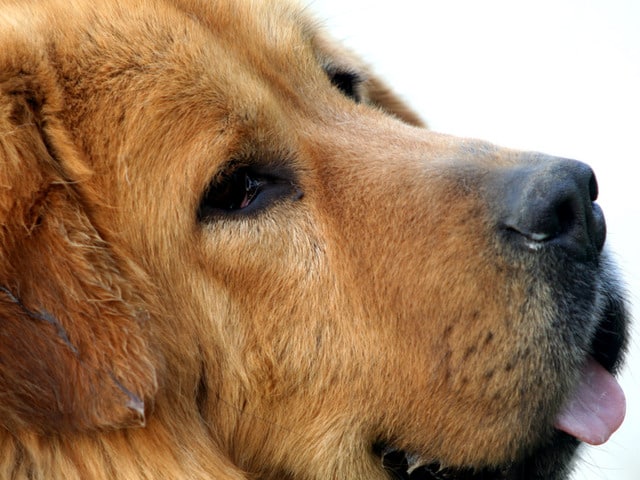
These massive dogs with their heavy coats and bushy tails are a giant, majestic breed of dogs. Weighing 80 to 150 pounds or more, they are calm and aloof guardians. They can be black, brown and blue/grey with or without tan markings and shades of gold. They are highly intelligent and independent in nature. Anyone hoping to own a Tibetan Mastiff has their work cut out for them.
These intelligent and dignified dogs may be too much for a novice dog owner to handle. They are mostly outdoor dogs and are fairly quiet inside the house. This breed is very protective of its family and property, so bringing people into your home may be difficult.
While this protective nature can make it a very attractive addition to your family, it is not the best dog for those with little to no experience with dogs. The owner needs to guide the dog with firm, kind and consistent training. The use of force or cruelty is an absolute no-no. Arguing in front of these dogs is not a good idea as they may step between you to put an end to arguments. When left to supervise children play, they may also mistake rough games among kids as attacks and step in to protect the children of their family.
History of the Tibetan Mastiff
The history of this breed is a lot of legend and very little information. There are no accurate records of the genetic heritage of a Tibetan Mastiff but they are usually found in the high Himalayan Mountains and the plains of Central Asia.
They are considered by many to be the basic stock from which most of the modern large working breeds have developed. A lot has been written about them since the 17th century, yet there are few specifics available. Earliest accounts place a large dog around 1100 BC in China. Forefathers of today’s Mastiff breeds are believed to have accompanied the armies of Assyrians, Persians, Greeks and Romans and later even travelled with Atilla the Hun and Genghis Khan all the way up to Europe.
But in all this, the majestic Tibetan Mastiff stayed contentedly perched in the high plateaus and valleys of the Himalayas and became one of the most prized possessions of the people of Tibet. However, you would be hard pressed to find a pure Tibetan Mastiff in Tibet, Nepal, Bhutan or other Himalayan regions but they are still bred by the nomads of the Chang-Tang plateau.
Grooming for Your Tibetan Mastiff
This breed of dog has a lush coat and it needs to be regularly brushed to keep it shipshape. A good brushing keeps the coat and skin healthy by stimulating the oil glands and keeps the coat shiny. It also helps avoid the skin under the coat getting irritated. These dogs have a thick double coat made up of a soft and wooly undercoat and a long, coarse topcoat.
Brushing encourages fur separation and ensures that warm air circulates next to the skin. This allows the dog to keep warm naturally. A wet Tibetan Mastiff can take days to dry off if not groomed properly. In the summers this coat can get overheated and cause infections on the skin or develop hot spots if not brushed adequately. Brush your Tibetan Mastiff a couple of times every week to remove loose hair. Keep the coat separated as well to protect against fleas and ticks. A Tibetan Mastiff sheds only once a year during spring, surprising considering its thick coat.
Training a Tibetan Mastiff
These are strong-willed dogs and will test your resolve when you set out to train them. Like children, they need responsible parents who can provide the right encouragement and love. They need to be raised together and included as much as possible in daily activities or they become bored, resentful, disobedient and destructive. They need a well-fenced open area to run around in — at least 6 feet high and 3 feet below.
This breed bonds as puppies with other pets and livestock, and can gauge tension levels and surrounding aura, making them the perfect guardians of livestock. Their ability to learn is influenced by genetics, hormones, senses and external stimuli received. The more stimulation the dog receives from early puppy hood the better he will learn. They learn best through patience and with suitable rewards. The rewards, however, need to be given within a second of getting the desired response from the dog.
The training should take place in a quiet environment and when the dog fails an exercise simply start again. A simple ‘uh huh’ is enough to reprimand the dog, never abuse or shout at him, this will only confuse him and in worse cases make it aggressive. Space out the training in three ten-minute sessions through the day, and make sure they are separated by a few hours at least. Always end these sessions with an exercise your dog can do well and loves. This will make the dog look forward to them.
Health Issues Common to Tibetan Mastiffs
About one-third of this breed is affected by hypothyroidism. Orthopedic diseases like hip dysplasia and elbow dysplasia are serious problems owing to its size and weight. Eyelid abnormalities (entropion and ectropion) including progressive retinal atrophy are common to this breed. Food allergies from soy and wheat have also been observed and can cause skin ailments as a result. They are also susceptible to ear infections.
A serious neurological problem faced by this breed is polyneuropathy, or canine inherited demyelinative neuropathy, CIDN. They are also at a higher risk for the emergency gastrointestinal syndrome called bloat.
This beautiful breed loves a dry, cold environment and can become an integral part of your homestead given the right training and love. Villages in the Himalayan regions used to have only one of these guarding the whole village. This dog has an uncanny, almost human, understanding given its long relationship with man. They have been bred as protectors of livestock, women and children.
They are the perfect example of controlled strength, initiative and fearlessness with patience, loyalty and gentleness when raised right. So if you are thinking about getting yourself a Tibetan Mastiff, make sure you are up to the task.





